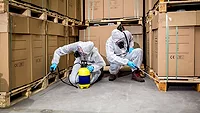Pest prevention: What a technician sees

A discerning eye for signs of something out of place. The instincts to anticipate where a problem is likely to take place and when. The expertise to solve the problem and prevent it from happening again. This sounds like the description for a character in a spy thriller, but it’s actually a list of the qualities food processors need in the pest management technician who services their plant.
The commercial pest management technician is one of the most valuable sets of eyes and ears when it comes to preventing and solving pest issues.
That’s because technicians are trained to question why things look different and look beyond the obvious to identify the root cause of a pest problem. They are investigators who will, on a tablet or smartphone, analyze data collected from traps and sensors, and combine that with intelligence gathered the old-fashioned way – by talking face-to-face with people.
The technician who services your facility will crawl into spaces that others don’t want to go – under and above equipment, catwalks and store rooms, to investigate for pest access points, conducive conditions and tell-tale signs of pest presence.
Your facility’s pest management technician, however, can’t be everywhere at once. They are, at most, in your plant on a weekly basis, but many times just once a month. That’s why it’s important to have your staff “see what a technician sees” and become another resource to prevent pests.
Here is a list of telltale indicators that pests could be threatening your facility:
Rodent tracks
What may look like roller marks from equipment in a dusty basement storage room, or small footprints and drag marks on an I-beam above the production floor, may be signs that rodents are present.
Maintenance personnel changing light bulbs or performing routine maintenance tasks may also notice these signs on the tops of light housing units. If they see something odd, they should say something to their pest management technician or make a notation in the pest log book.
Looking for quick answers on food safety topics?
Try Ask FSM, our new smart AI search tool.
Ask FSM →
Gnawed boxes
What may look like boxes damaged by a forklift or the misplaced boot of an employee may actually be gnaw marks from rodents. Employees should never assume damage to packaging was caused by human actions.
Below are some distinctive signs that rodents are present in your facility:
- Damage to boxes high on storage racks.
- Rodent droppings inside the shrink wrap.
- Distinctive chew marks on packaging with a smaller imprint than a human or machine would cause.
- In addition to droppings, there may be staining or damp packaging from rodent urine.
It’s also important to check boxes, rubber door sweeps or weather stripping around loading dock doors and windows, which are vulnerable to rodent gnawing.
Outdoor tracks/burrows
What may look like an area where grass is beaten down by water drainage or foot traffic may actually be a path traversed by rodents or other small animals. These pests create trails on the exterior of a structure as well as burrows. You can usually find these along railroad sidings, drainage ditches and retention ponds.
When performing maintenance on the exterior of your facility, keep an eye open for beaten down grass or holes with fresh dirt, flies or hair. Ask who created that hole because it certainly may be a pest.
Smear marks
What may look like smudge marks from a forklift tire along a wall or baseboard may actually be rodent sebum trails. Sebum is the oily, waxy substance on a rodent’s skin and hair.
Since rodents prefer to travel along walls, baseboards, beams or boxes, they will leave their mark – usually a dark smudge – along their route. If you see unexplained rub marks near openings in baseboards or areas where a forklift wouldn’t be able to go, this merits further investigation.
Review trap activity in these areas to help identify where the rodents are coming from and where their sources of food and/or harborage are located.
Insect tracks
What may look like squiggly lines on processing equipment or structural beams may be trails or tracks from adult insects or immature larvae.
In areas where dust builds up, warehouse beetle larvae tracks can be seen on equipment, structural supports and food storage or transportation racks. If larvae aren’t found in time, pests, like the highly destructive Indian meal moth, will be found flying up to 8 feet away from the food source.
Employees should not only look at food or ingredients for signs of insect presence, but up walls, in storage racks and around and under equipment for signs of pests.
Mold
What looks like a dimly lit, dark spot in an infrequently visited or hard-to-access area of a third-party food storage warehouse or distribution facility may in fact be mold that could attract springtails, psocids and other mold-feeding insects, such as foreign grain beetles.
Maintenance staff should watch for wet lines along exterior walls or blocked gutters that allow moisture inside these areas. Food processors should also talk with third-party vendors about storage conditions in their facilities, and make sure they are in compliance with their requirements.
Share these findings with your pest management technician, so they can further investigate and ensure your exterior rodent programs are up to par.
With zero-tolerance for pests now the norm, it is important to have as many eyes watching for signs of pest activity or conditions that attract pests in a food processing facility. Training your staff to recognize the signs of a potential pest threat and working in partnership with a pest management technician is the formula for a successful, effective pest control program.
This article was originally posted on www.refrigeratedfrozenfood.com.







